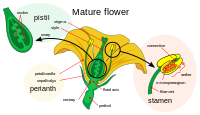
Photo from wikipedia
The Dilleniaceae is known to produce nectarless flowers pollinated by bees, but the fact that bats ingest Dillenia biflora pollen led us to question pollination assumptions for these trees. We… Click to show full abstract
The Dilleniaceae is known to produce nectarless flowers pollinated by bees, but the fact that bats ingest Dillenia biflora pollen led us to question pollination assumptions for these trees. We aimed to identify the pollinators of D. biflora, check for nectar presence, and investigate potential for cleistogamy and global prevalence of this pollination system. We examined aspects of the pollination of D. biflora on two Fijian islands using video recordings, direct observations, hand pollination, measurements (flowers, bite marks, nectar), and monitoring. The flowers, receptive for one night, contained copious nectar and had permanently closed globose corollas that required removal by bats for pollination. All the 101 flowers that retained their corolla died and did not produce seeds by cleistogamy. The bat Notopteris macdonaldi was well adapted to corolla removal. Keeping corollas closed until bats manipulate the nectar-rich flowers is a beneficial strategy in high-rainfall environments with many flower parasites. We propose to name a pollination system reliant exclusively on bats “chiropteropisteusis.” From clues in the literature, other species in the geographical range of Dillenia are probably chiropteropisunous. Chiropteropisteusis should be investigated in the Old-World range of Dillenia, many species of which are threatened. The remarkable “fall” of the entire corolla observed by an earlier botanist for several species in the genus is most likely attributable to bats. This discovery has important implications for the conservation of bat-dependent trees and their associated fauna, particularly considering the high level of threat faced by flying-foxes globally.
Journal Title: PLoS ONE
Year Published: 2022
Link to full text (if available)
Share on Social Media: Sign Up to like & get
recommendations!